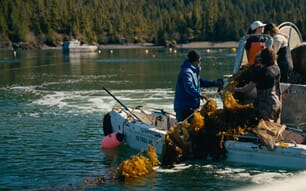
Lankard is increasingly looking towards aquaculture as a means to revive the fortunes of Indigenous coastal communities in Alaska
An Eyak Athabaskan Native from Cordova (once called Eyak), Lankard’s life was irrevocably altered by the 1989 Exxon Valdez oil spill – a disaster that devastated Prince William Sound and much of Alaska’s southern coastline. As a commercial fisherman, he witnessed the ecological and cultural collapse that followed, and it lit a fire beneath him.
“We used to make a good living off the sea, the forest, the land – and in a matter of days, that disappeared,” he reflects. “Our food, our work, our way of life – gone.”
Rather than despair, Lankard embraced a flurry of activity, founding several non-profit organisations, including the Eyak Preservation Council and the Native Conservancy, the first Native-led, Native-owned land trust in Alaska, in a bid to ensure that Alaskan Natives remain the stewards of their ancestral lands and waters.
Lankard’s efforts, along with Alaskan NGOs, have resulted in the protection of over one million acres of the state, from old-growth rainforests to critical salmon habitat. But he’s now increasingly turning his attention to the ocean – specifically, to the cultivation of kelp and shellfish to regenerate the economies of coastal Native communities.
“Our oceans are hurting. But seaweed, oysters – they don’t take, they give,” Lankard explains. “It’s a food system that heals rather than harms.”
For Lankard, regenerative ocean farming is also a form of cultural reclamation. He notes that his ancestors have long harvested kelp and shellfish, but those practices were disrupted by colonisation, overfishing and pollution.
“We’re not just growing food. We’re growing back who we are - ocean guardians,” he reflects.
Overcoming technical hurdles
Tiffany Stephens, the director of Ocean Back at the Conservancy, who brings a wealth of seaweed research experience to the table, is working with Lankard to help Alaskan communities gain mariculture permits and as well as an understanding of how and where to best grow kelp.
She highlights some of the technical hurdles that need to be overcome before mariculture proves profitable.
“There are numerous barriers to entry – everything from workforce development, marketing, processing, dehydration, transportation to market, renewable energy, application to offset the high cost of doing business on the ocean.”
However, the Conservancy is helping to break down some of these technical barriers and worked both with the Chugach Regional Resources Commission and the Alutiiq Pride Marine Institute to improve the ocean farm site selection process for kelp farms.
This project includes establishing a network of test farm sites in Prince William Sound to determine which kelp species thrive in specific marine conditions and how best to scale sustainable production. The team has been studying native kelps like bull kelp, sugar kelp and ribbon kelp, aiming to match each species to its ideal cultivation environment.
“Each region is going to be different because the temperatures of the ocean is going to be a little bit different... There’s a lot of variables to this industry,” explains Stephens.
To support these efforts, the Conservancy is deploying data buoys that track salinity, temperature, pH levels and how biomass accrues on the lines – all critical for determining optimal growing conditions.
“We’re building these magic buoys... so we can figure out what can grow where,” says Lankard. “You can figure out how much you can grow per square foot, and even how much carbon you're sequestering.”
The Conservancy is also testing processing methods, both onshore and at sea, aiming to retain the nutritional integrity of kelp while minimising handling.
“We visualised that we should be figuring out how to process the kelp at sea... so the quality is maintained, therefore the price point stays up,” Lankard notes.

Stephens aims to help Alaskan communities gain mariculture permits as well as an understanding of how and where to best grow kelp © Hatch Blue Consulting
Big ambitions for bivalves
Alongside kelp, the Conservancy is laying the groundwork for a robust bivalve mariculture programme, including oysters, mussels, scallops and clams.
“We figured, let’s make our move to figure out how we are going to not only grow kelp but also bivalves,” says Lankard. “If you are growing four or five or even six or seven different types of species, then you're going to have a sustainable restorative income.”
The ecological benefits are central to their vision: bivalves are natural filter feeders, capable of cleaning 40 to 60 gallons of water each per day, improving water clarity and health, while thriving in harmony with kelp.
“They can grow together in their one happy family,” Lankard notes, highlighting the compatibility between kelp and bivalves.
The true measures of success
For Lankard, success of the project shouldn’t be measured solely in dollars – it’s about a new ripple of impact, including sovereignty, sustainability and spiritual alignment.
“What’s the true value of a healthy ocean? Of a people feeding themselves, on their own terms,” he asserts.
While Lankard’s work is grounded in Alaska, its implications are far-reaching. As the world grapples with climate change, food insecurity and biodiversity loss, Indigenous-led regenerative farming offers a hopeful model.
“We have a roadmap. We’ve lived in balance with the ocean for thousands of years. The world is finally starting to listen.”
“We’re not trying to save the world, we’re just trying to save our little part of it. And maybe, just maybe, it helps others save their endangered habitat too,” he concludes.
*This article is part of a project commissioned by the SEC to highlight the region's mariculture sector. To learn more about the sector visit https://alaska.seaweedinsights...








